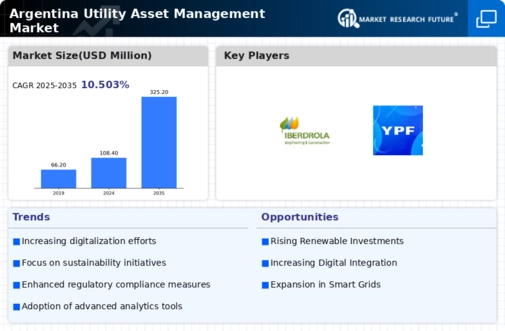Regulatory Framework Enhancements
The evolving regulatory framework in Argentina is a critical driver for the utility asset-management market. Recent reforms aimed at improving transparency and accountability in utility operations are prompting companies to adopt more robust asset management practices. The introduction of stricter compliance requirements is likely to compel utilities to invest in advanced management systems that ensure adherence to regulations. This shift not only enhances operational efficiency but also fosters consumer trust. As the regulatory landscape continues to evolve, the utility asset-management market must adapt to these changes, ensuring that companies remain compliant while optimizing their asset management strategies.
Growing Demand for Renewable Energy
The shift towards renewable energy sources is significantly influencing the utility asset management market in Argentina. With the government targeting a 20% contribution from renewables to the energy mix by 2025, utility companies are compelled to adapt their asset management strategies accordingly. This transition not only necessitates the integration of renewable assets but also requires enhanced management practices to optimize performance and reliability. The investment in solar and wind energy projects is projected to reach $10 billion by 2025, indicating a robust growth trajectory. Consequently, the utility asset-management market must evolve to accommodate these changes, ensuring that assets are effectively managed to meet the increasing demand for clean energy.
Increased Focus on Customer Engagement
the utility asset management market in Argentina is witnessing a heightened emphasis on customer engagement. Utilities are recognizing the importance of fostering strong relationships with consumers to enhance service delivery and satisfaction. This trend is prompting companies to invest in customer relationship management (CRM) systems and digital platforms that facilitate better communication and feedback mechanisms. By prioritizing customer engagement, utilities can gain valuable insights into consumer preferences and expectations, which can inform asset management strategies. As a result, the utility asset-management market is likely to evolve, with a greater focus on aligning services with customer needs and improving overall service quality.
Investment in Infrastructure Development
the utility asset management market in Argentina is experiencing a surge in investment aimed at infrastructure development. The government has allocated approximately $5 billion for the enhancement of energy and water supply systems, which is expected to bolster the efficiency of asset management practices. This influx of capital is likely to facilitate the adoption of advanced technologies, thereby improving operational performance. Furthermore, the focus on modernizing aging infrastructure is crucial, as it can lead to reduced maintenance costs and enhanced service delivery. As a result, stakeholders in the utility asset-management market are increasingly prioritizing infrastructure projects to ensure long-term sustainability and reliability of services.
Technological Advancements in Asset Management
Technological advancements are reshaping the utility asset management market in Argentina. The adoption of smart grid technologies and IoT solutions is becoming increasingly prevalent, enabling utilities to monitor and manage assets more effectively. These innovations facilitate real-time data collection and analysis, which can lead to improved decision-making and operational efficiency. The market is projected to grow at a CAGR of 8% over the next five years, driven by the need for enhanced asset visibility and performance. As utilities embrace these technologies, they are likely to experience reduced operational costs and improved service reliability, thereby transforming the landscape of the utility asset-management market.

















Leave a Comment